Difference between revisions of "Rolleicord Vb"
(added v2 and v3 photos) |
(article links misc wording) |
||
| Line 1: | Line 1: | ||
| − | The | + | The '''Rolleicord Vb''' is the last model in a long line of [[Rolleicord]]s which started in 1933 |
and ended in 1977 and were produced by [[Franke & Heidecke]] and later on by [[Rollei]]-Werke in Braunschweig, Germany. | and ended in 1977 and were produced by [[Franke & Heidecke]] and later on by [[Rollei]]-Werke in Braunschweig, Germany. | ||
| − | It is a medium format TLR | + | It is a [[medium format]] [[TLR]] camera that uses [[120 film|120]] type Rollfilm. 12 6x6cm square images can be captured for each roll of 120 film. There are 2 Mask-sets available. One set gives 16 images in size 4x4cm or 4x5.5cm. Another set gives 24 images in 28x40mm or 24x36mm. These mask-sets also contain the right film counter which is exchangeable on the Vb.{{br}} |
| − | There are 2 Mask-sets available. One set gives 16 images size 4x4cm or 4x5.5cm. | + | By using an optional Rolleikin adapter [[35mm|135 format]] film cartridges can be used. |
| − | Another set gives 24 images 28x40mm or 24x36mm. These mask-sets also contain | ||
| − | the right | ||
| − | By using an optional Rolleikin adapter | ||
A major difference with its predecessor, the Va, is that it has a removable hood | A major difference with its predecessor, the Va, is that it has a removable hood | ||
and the viewer screen can be easily accessed for cleaning or swap with another type. | and the viewer screen can be easily accessed for cleaning or swap with another type. | ||
| − | All Vb's were | + | All Vb's were equipped with a [[Schneider]]-Kreuznach Xenar 1:3.5 75mm lens. |
Viewing lens is a Heidosmat 1:3.2 75mm. Before both lenses is a Bayonet mount Size 1 for filters, lens hood, etc.. | Viewing lens is a Heidosmat 1:3.2 75mm. Before both lenses is a Bayonet mount Size 1 for filters, lens hood, etc.. | ||
Revision as of 03:19, 12 May 2013
The Rolleicord Vb is the last model in a long line of Rolleicords which started in 1933 and ended in 1977 and were produced by Franke & Heidecke and later on by Rollei-Werke in Braunschweig, Germany.
It is a medium format TLR camera that uses 120 type Rollfilm. 12 6x6cm square images can be captured for each roll of 120 film. There are 2 Mask-sets available. One set gives 16 images in size 4x4cm or 4x5.5cm. Another set gives 24 images in 28x40mm or 24x36mm. These mask-sets also contain the right film counter which is exchangeable on the Vb.
By using an optional Rolleikin adapter 135 format film cartridges can be used.
A major difference with its predecessor, the Va, is that it has a removable hood and the viewer screen can be easily accessed for cleaning or swap with another type.
All Vb's were equipped with a Schneider-Kreuznach Xenar 1:3.5 75mm lens. Viewing lens is a Heidosmat 1:3.2 75mm. Before both lenses is a Bayonet mount Size 1 for filters, lens hood, etc..
Contents
Rolleicord Vb version 1
This first version was produced from 1962 till 1966.
The shutter is a Deckel Synchro-Compur MXV/CR00 offering speeds from 1 till 1/500 second, a B setting, a selftimer and X and M flash-synchronisation.
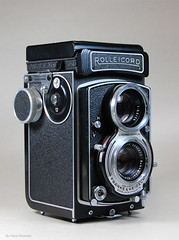 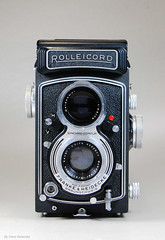 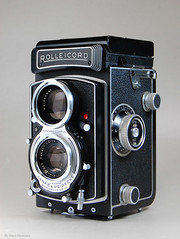
|
| Rolleicord Vb, first version , Xenar f3.5/75mm lens, Synchro-Compur MXV/CR00 shutter. Images by Hans Kerensky. (Image rights) |
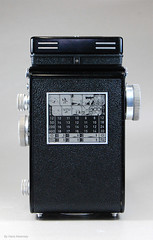 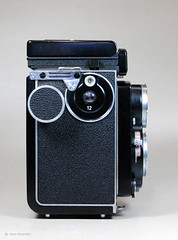 
|
| Rolleicord Vb, first version ,Back and Side views . Images by Hans Kerensky. (Image rights) |
Rolleicord Vb version 2

|
| Vb version 2 image by Rachel Rayns (Image rights) |
This second version was produced from 1966 till 1970.
The shutter is a Deckel Synchro-Compur XV/CR00 offering speeds from 1 till 1/500 second, a B setting, a selftimer and X flash-synchronisation.
Rolleicord Vb version 3
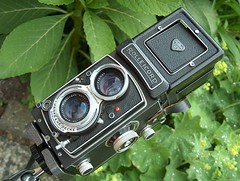
|
| Vb version 3 image by Gerard Vogels (Image rights) |
This third version was produced from 1970 till 1977. It is in fact not a separate version but merely a version 2 with another frontplate, the so called "white face".
Rolleicord Vb special versions
Special versions were made for Philips, an electronics company in The Netherlands and for the German Police (Polizei).
References
Bibliography
- Claus Prochnow, Rollei Report 2, Braunschweich, Lindemanns Verlag, 2008, ISBN 3-89506-220-0.